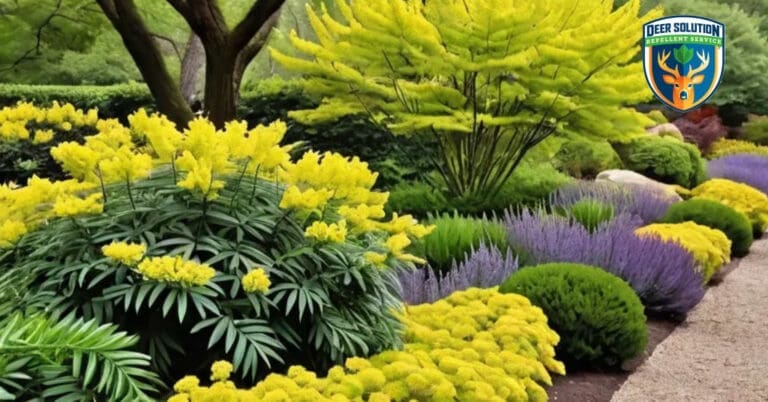Leatherleaf Mahonias (Mahonia bealei) are known for their distinctive, spiny foliage and bright yellow flowers, making them a popular choice for gardeners seeking unique yet hardy plants. One common question that arises is, do deer eat Leatherleaf Mahonias? While these shrubs are generally considered deer-resistant, several factors can influence whether deer decide to browse on them. In this guide, we explore how Leatherleaf Mahonias fit into a deer-resistant garden and how you can use them to create a resilient landscape.
Why Deer Avoid Leatherleaf Mahonias
Leatherleaf Mahonias are often regarded as deer-resistant due to their tough, spiny leaves, which make them less palatable to deer. The coarse texture of the leaves and stems creates a natural defense, making these plants unappealing to most herbivores. Additionally, the slightly bitter taste of the plant can deter deer from browsing on it, especially when more tender, flavorful vegetation is available.
However, it’s important to note that no plant is entirely immune to deer. In times of food scarcity, such as during harsh winters or droughts, deer may sample plants they usually avoid, including Leatherleaf Mahonias. In regions with high deer populations, the competition for food can push deer to browse on less preferred species. Observing local deer behavior can help you better predict how they might interact with these shrubs.
Companion Planting with Leatherleaf Mahonias
Incorporating Leatherleaf Mahonias into a deer-resistant garden is an effective way to reduce the likelihood of deer damage. To enhance this strategy, consider companion planting with other deer-resistant species. Plants like lavender, yarrow, and ornamental grasses are excellent choices for pairing with Leatherleaf Mahonias. These plants not only complement the shrub’s aesthetic appeal but also help create a natural barrier that deters deer from venturing further into your garden.
Additionally, using aromatic herbs such as rosemary or sage around the edges of your garden can further enhance its deer-resistant qualities. The strong scents of these herbs act as natural repellents, making your garden less attractive to deer.
Designing a Resilient Garden with Leatherleaf Mahonias
Strategic garden design can play a significant role in protecting your plants from deer. When planting Leatherleaf Mahonias, consider their placement within your landscape. Positioning these shrubs closer to your home or in more protected areas can reduce the likelihood of deer encounters. For example, placing Leatherleaf Mahonias near taller, more deer-resistant plants or using them in conjunction with physical barriers like fences can offer extra protection.
Layering your garden with a mix of tall, medium, and low-growing deer-resistant plants creates a visually appealing and functional design that makes it more difficult for deer to navigate. By using plants like boxwood or holly as outer defenses and placing Leatherleaf Mahonias within this perimeter, you create a layered approach to deer management that blends beauty with practicality.
Adjusting for Seasonal Deer Activity
Deer feeding patterns shift throughout the year, and adapting your garden care practices to these changes can make a big difference in minimizing damage. During the winter months, when food sources are limited, deer are more likely to browse on less desirable plants, including shrubs like Leatherleaf Mahonias. In these seasons, consider adding extra protection, such as applying deer repellent sprays or using burlap to shield your plants.
Regularly monitoring your garden for signs of deer activity can also help you respond quickly before significant damage occurs. Observing deer trails and feeding patterns can give you insight into which parts of your garden are most vulnerable, allowing you to adjust your protective measures accordingly.
Promoting Pollinator and Wildlife-Friendly Gardens
Leatherleaf Mahonias are not only valued for their deer resistance but also for their ability to support local wildlife. Their early-spring blooms attract pollinators, including bees and butterflies, which play a crucial role in maintaining garden biodiversity. Additionally, the berries produced by these shrubs can provide food for birds, making Leatherleaf Mahonias an excellent addition to a wildlife-friendly garden.
By incorporating Leatherleaf Mahonias and other pollinator-attracting plants, you create a balanced ecosystem where wildlife can thrive, all while reducing the likelihood of deer damage. This approach to gardening benefits the environment and contributes to the overall health of your landscape.
A Deer-Resistant Garden that Thrives Year-Round
While addressing deer-related challenges in your garden can seem daunting, selecting deer-resistant plants like Leatherleaf Mahonias, combined with strategic garden design and seasonal adjustments, provides a solid foundation for a thriving landscape. By understanding the dietary preferences of deer and using plants that naturally deter them, you can protect your garden from damage without resorting to harmful chemicals or invasive techniques.
Exploring sustainable gardening solutions leads us to consider how professional services, like those offered by Deer Solution, provide tailored support for maintaining the health and beauty of your landscape. With expert guidance and eco-friendly repellents, Deer Solution helps ensure that your garden remains vibrant and resilient against deer browsing. Together, these strategies create a well-protected and flourishing outdoor space that you can enjoy all year long.








